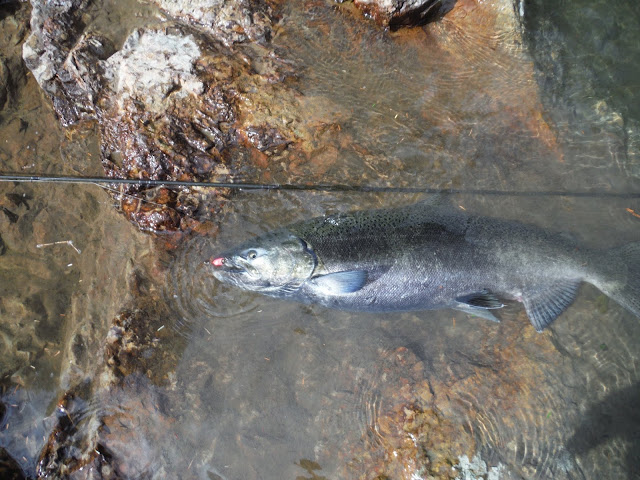September is the time when those who don’t have boats
have a good chance of bringing a 30-pounder home from a river. Examples of
rivers to try, include the San Juan, Nitinat, Somass/Stamp and Campbell/Quinsam.
Do check the regulations for possible closures aimed at protecting fish during
spawning, and in certain pools.
Many other rivers have chinook as well, but with the
low water events lengthening with climate change, and chinook needing almost a
foot of water to migrate the shallows, most rivers have places that chinook
cannot ascend. This means you may find them in the saltwater approaches or
bunched together in river pools below shallow spots. Get to know your rivers,
and you can make an educated guess where the chinook will be found before the
rains of autumn arrive in earnest.
Chinook, like pink salmon, tend to stop a lure, rather
then hit and run. You have to recognize when that has happened and strike.
Chinook scrunch together in schools that sometime reach 10,000 fish, a black
spot in the deep water, usually on the other side of the river.
The rig of choice is a piece of yarn on a size 3/0 to
6/0 single hook on a leader of 18- to 24-inches of 20-pound test and an ounce
of pencil lead crunched on the tag end from a swivel, also connected to the
mainline of minimum 20-pound test. Before tying the main line to the swivel, it
is threaded through the top sleeve of a dink float, then circles the float, and
finally is threaded into the bottom sleeve mounted in the float. The purpose is
to be able to adjust the float up and down on the mainline, until the rig presents
at eye level.
The rig is slung up-river of the school, line mended
from rod tip to float once it hits the water, and the rig passes down stream through
the school. If a passive bite is received – chinook stop the yarn with their
mouths, then release it – strike up hard and brace for a big fight, enjoyed
once the fish is safely on your shore, humanely bonked. The passive bite is
noted by the float disappearing under the water, and because the chinook will
let the yarn go, you have to watch the float and strike immediately, when it
disappears.
All fish not hooked in the mouth, must be released. Many
gear anglers won’t do this. That is because many gear fishermen use a rig that
foul hooks so many fish they may not fairly hook a fish all day. It is neither
lawful nor fishing to cast a weighted line, yarn/hook on the end, to the other
side of a wall of flesh and then reel in, hooking fish wherever the hook
penetrates the wall. Do remember we want fish that will not be retained to
spawn. It makes no sense to stress fish all day long when they need to be
frisky enough for sex and death.
In certain years and on certain rivers, chinook will
bite a spoon or spinner. The large Gibbs Ironhead, Illusion, Kit-A-Mat and so
on cast a mile. Cast above the school and allow the current to swing the lure
across as many eyeballs as you can manage, the chinook reaching out to what it
sees crossing its path and nabbing it. Large size 5 spinners will also take
chinook some years. The spoons have a base of silver or gold, spinners, both
silver blades and most often pink or chartreuse bells.
If your lure drops to the bottom, leave it there a bit
and you may receive a bite. Chinook, the only species of salmon that will do
this, will actually go down to the bottom and pick up shiny lures. What nice
fish. And a method of fishing practiced in water that the angler knows before
doing it that the bottom is small gravel, and not snaggy.
Here is a small school of chinook in early autumn:
Here is a chinook caught on a spinner:


No comments:
Post a Comment